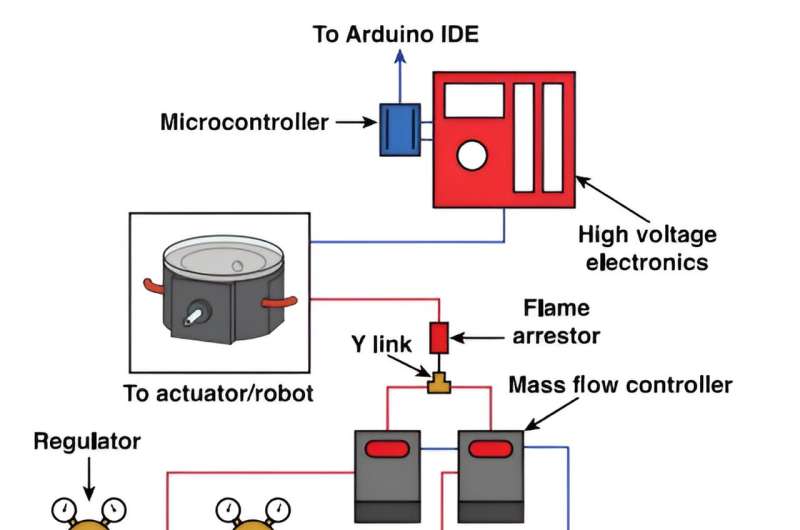September 15, 2023 report
This article has been reviewed according to Science X's editorial process and policies. Editors have highlighted the following attributes while ensuring the content's credibility:
fact-checked
peer-reviewed publication
trusted source
proofread
Using tiny combustion engines to power very tiny robots

A team of mechanical engineers at Cornell University, working with a colleague from Technion-Israel Institute of Technology, has designed and built a tiny robot that is powered by a combustion engine. In their paper published in the journal Science, the group describes how they built their tiny engine and possible uses for it. Ryan Truby, with Northwestern University, has published a Perspective piece in the same journal issue outlining the work done by the team on this new effort.
Over the past several decades, roboticists have designed and built ever-smaller robots with the goal of finding a design that can be used for a variety of unique purposes. Virtually all of them have been powered by batteries. But as the size of such robots continues to shrink, it becomes increasingly difficult to power them using battery technology. In this new effort, the researchers have turned to an old technology as a solution—an internal combustion engine.
An internal combustion engine exploits the power of a controlled explosion by using it to push a moving part, such as a piston in a car engine. Repeated explosions create a continual force allowing a car to move on a road. In this new effort, the research team found a way to make a tiny combustion engine using methane vapor and oxygen instead of gasoline, and used it to power a tiny robot.
To build their engine, the researchers started by building a tiny combustion chamber along with a sparking agent to set off an explosion. When that happens, the top of the chamber is pushed slightly upward, like a piston. Testing showed the piston could exert a force of 9.5 newtons. The team also designed a pump that worked in conjunction with the igniter to allow the piston to be moved up and down approximately 100 times a second.
They then built a second engine identical to the first and connected both to serve as feet and legs for a tiny frog-shaped robot. The robot, they found, could be made to jump if both engines were fired at the same time, or to walk, if the engines were fired alternating style.
The research team notes that the engines are small enough that four of them could sit on the face of a penny and that they weigh just 325 milligrams each. They do acknowledge that some of the parts have yet to be miniaturized, such as the fuel system and holding tank and the power source for the spark generator. Still, they suggest their design could prove useful for making a variety of tiny robots.
More information: Cameron A. Aubin et al, Powerful, soft combustion actuators for insect-scale robots, Science (2023). DOI: 10.1126/science.adg5067. www.science.org/doi/10.1126/science.adg5067
Ryan L. Truby, Chemically fueling new microrobot abilities, Science (2023). DOI: 10.1126/science.adk0522
© 2023 Science X Network

















